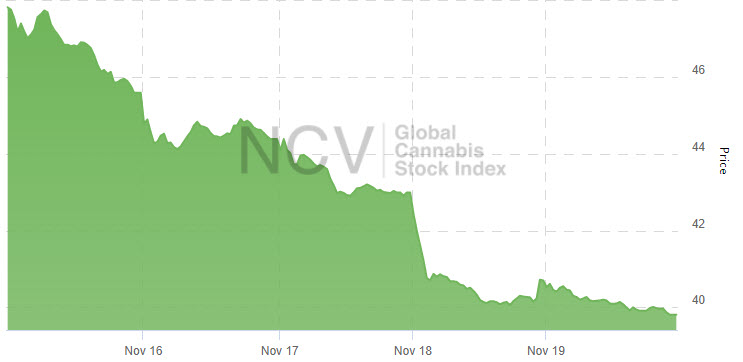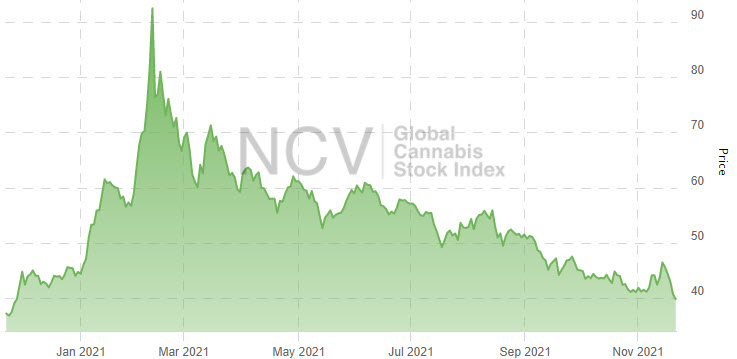Navigate the fast-moving cannabis sector with 420 Investor, a premium service that sends real-time alerts and explanations of the news below and much more.
Summary
- Representative Mace unveiled her cannabis legalization bill.
- Germany may move to legalize cannabis for adult-use.
- Canadian retail sales grew 38% in September.
- Health Canada added 3 new licenses, leaving the total now at 788.
- 420 Investor model portfolios have returned -1.6% to 46.1% year-to-date, while the Global Cannabis Stock Index has lost 10.3%.
Review
Representative Mace formally introduced her cannabis legalization bill, States Reform Act. Germany’s political parties agreed to move towards adult-use legalization.
Retail sales in Canada grew 38% in September, up marginally from August, to a record $355 million. Health Canada added 3 licenses, leaving the total at 788, including 1 that is expired, revoked or suspended.
During the week, I shared these insights with subscribers at 420 Investor:
- Model Portfolio Composition 11/12/21
- Cannabis Sub-Sector Review – 11/12/21
- Previews of Q3 Financial Reports from Greenlane, TerrAscend and Verano
- Previews of Upcoming Financial Reports for Organigram and Planet 13
Here are some of this week’s highlights for 420 Investor Focus List names:
- AAWH began delivery from its second adult-use store in Massachusetts, located in Newton.
- CCHWF introduced Tyson 2.0 in Colorado
- CGC introduced 10 new premium strains in Canada. Its CFO and Chief Product Officer both departed abruptly, with interim replacements named.
- CRLBF opened its relocated Sunnyside Wrigleyville store in Chicago
- CURLF has engaged Southern Glazer’s Wine & Spirits to distribute Curaleaf Hemp and Select CBD
- CWBHF revenue fell slightly due to a mix shift, with Q3 revenue of $23.7 million and adjusted EBITDA of -2.8 million.
- GNLN reported revenue of $41.3 million increased from a year ago, but, excluding the addition of a month of KushCo, it declined slightly. Adjusted EBITDA was -$6.9 million.
- GRAMF revenue of $39.7 million fell sharply due to a decline in its wholesale business, with adjusted EBITDA of -$16.2 million.
- LOWLF Q3 revenue fell 18% from Q2 due to depressed wholesale prices, with adjusted EBITDA of -$5.2 million. It expanded its relationship to three states for its licensing agreement with Ascend, adding Michigan.
- OGI introduced a new wellness brand, Monjour, with CBD offerings
- SHWZ Q3 revenue increased 4% sequentially to $31.8 million, with adjusted EBITDA of $8.8 million. It announced two pending acquisitions, including $4 million for Glendale, CO dispensary Smoking Gun and $29 million for Emerald Fields, which operates two dispensaries in Colorado (Glendale and Manitou Springs).
- TCNNF reported Q3 revenue of $224 million, up 64% and ahead of expectations, with adjusted EBITDA at $98 million. On a pro forma basis including Harvest, revenue would have been $316 million with adjusted EBITDA of $121 million.
- TLLTF reported a 37% increase in Q3 revenue to $53.4 million with adjusted EBITDA of $5 million. The company began adult-use sales in Massachusetts and received permission from the state to do so from its second store.
- TRSSF reported Q3 revenue of $49.1 million, a 16% sequential decline and up 29% from a year ago, with adjusted EBITDA of $10.5 million. It acquired property in Maryland to build a larger cultivation and processing facility.
- VFF acquired 70% ownership of ROSE LifeScience for C$46.7 million, opening the Quebec market to it.
- VLNCD executed a 3:1 share consolidation ahead of its NASDAQ listing
- VRNOF Q3 revenue expanded 4% sequentially to $207 million, with adjusted EBITDA of $111 million. It moved to unlock the remaining shares that were subject to lock-ups ahead of schedule.
Market Performance
The Global Cannabis Stock Index wiped out the gains from the prior two weeks, setting a new 2021 closing low on Friday, decreasing 14.3% during the week to 39.81:

The index, which lost 34.1% in 2019 and lost 54.9% in 2018 after gaining 91.8% in 2017 and 88.8% in 2016, was up 5.2% in 2020. It has lost 10.3% in 2021 thus far. It currently includes 42 stocks and ended 2020 at 44.39:
 Model Portfolios
Model Portfolios
420 Investor offers three model portfolios for subscribers, including two that are long-term focused and fully invested with a goal of beating the Global Cannabis Stock Index, 420 Opportunity and 420 Quality. 420 Opportunity ended the week valued at $114,853, down 16.6%. The model portfolio, up 9.0% in 2021, gained 35.6% in 2020 and has increased 129.7% since April 2014 despite the large loss in the index since then. 420 Quality ended the week at $158,975, down 17.1% for the week, and is now down 1.6% in 2021 after gaining 42.8% in 2020. The model was launched in March 2017 targeting long-term investors seeking to invest in leading cannabis stocks with low portfolio turnover and has gained 218.0% since inception compared to the 50.8% decline in the index since then. Flying High, which is focused on swing trades, ended the week valued at $368,714, down 17.1%. The model portfolio gained 52.7% in 2020 and is up 46.1% in 2021, and the return since inception in late 2013 has been 3587%.
Outlook
After a strong rally to begin 2019, the cannabis sector experienced a sharp decline over the next year to unprecedented levels due to several negative developments, including the CannTrust fraud, the surprise termination of Bruce Linton as CEO of Canopy Growth, a disappointing roll-out of legalization in Canada, regulatory confusion in the U.S. regarding CBD and a slow roll-out of legalization in California, the vaping crisis and then financial turmoil and market disruptions due to the COVID-19 pandemic. The sector saw capital available to fund expansion dry up, a situation that continues to leave companies operating with negative cash flow severely challenged, as the availability is limited to stronger operators.
Cannabis stocks overreacted and put in a bottom in March 2020, and benefited from a perception that the industry offers strong growth prospects, something that wasn’t clear then. A big change was that the pandemic caused many regulators to permit previously prohibited types of retail activities, like curbside pickup and delivery. The legal market rapidly capitalized on becoming even more convenient than the illicit market, with the ability to order online. States and municipalities moved to broaden adult-use and medical access. Access to capital improved dramatically, and the leading companies began generating large and rapidly growing revenue and profits.
The strong finish to 2020 continued into 2021 after the Democrats took control of the Senate in early January, but the stocks got way ahead of themselves and have been consolidating since then. In addition to concerns that federal legalization will take a longer time than many have expected, there have been some tough comparisons to year-ago sales levels. Additionally, while several institutions embraced the sector early in the year, there has been a lull in additional interest.
There are several potential catalysts ahead, including the FDA (or Congress) providing clarity on CBD regulation, progress in the Canadian legalization that commenced in October 2018 and that is beginning to include a broader set of products and the continued growth in German and Israeli MMJ and other international markets that have been slow to develop. The adult-use implementations in California and Massachusetts for adult-use were slow to roll out but are beginning to show great improvement. Michigan and Illinois legalized for adult-use at the end of 2019, and these markets are showing strong growth that could encourage other states to legalize. Voters in Arizona, Montana, South Dakota and New Jersey all approved adult-use legalization in November, and Connecticut, New Mexico, New York and Virginia have enacted legalization through the legislative process in 2021.
The big themes ahead are likely to be continued cross-industry investment into the sector and more consolidation in Canada and in the U.S., potential federal regulatory reform (SAFE Banking Act and other more comprehensive legislation, which could eliminate 280E taxation and enable trading on higher exchanges for MSOs as well as the broad usage of credit cards for cannabis purchases), steps to enable cannabis research, the roll out of MMJ in Germany, Mexico and in Australia as well as continued advances in South America and potential adult-use legalization in Germany, Israel and Mexico, new legal cannabis implementations in AZ, MT, NJ and SD, and MMJ implementations in AL, WV and VA, possible legalization via the legislatures in DE, FL, MD, MN, NH, PA and RI and implementation of the CT, NM, NY and VT commercial programs in 2022 and VA in 2024. It is interesting to see both parties embracing cannabis legalization legislation at the federal level, including the Republican bill, States Reform Act, and the Democrat bill, Cannabis Administration and Opportunity Act.
After bottoming in March 2020, the cannabis sector has been in a new bull market. Many companies are generating substantial revenue and some even a profit, and liquidity is much better. The sector has transitioned away from many legacy penny stocks that had never proven that they had viable businesses towards better capitalized companies, many of which have strong management teams and substantial businesses. The investor base has also transitioned, becoming increasingly more institutional.
